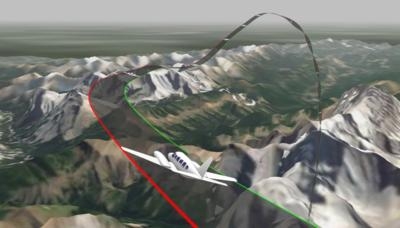Sat, Aug 03, 2019
Piper PA-31 Collided With Terrain In Kananaskis Country, Alberta
In the release of its investigation report (A18W0116), the Transportation Safety Board of Canada (TSB) found that hypoxia ... in-flight oxygen deprivation ... likely played a role in the loss of control that resulted in a fatal 2018 aircraft accident over Mount Rae, Alberta.

In the afternoon of 1 August 2018, after completing two hours of survey activities, an Aries Aviation International Piper PA-31 aircraft was proceeding to Calgary/Springbank Airport Alberta (CYBW), at 15,000 feet above sea level (ASL), with a pilot and a survey technician on board. Approximately 40 nautical miles southwest of the airport, air traffic control began sequencing the aircraft for arrival into the Calgary airspace. At this time, for reasons that could not be determined, the right engine began operating at a significantly lower power setting than the left engine. About 90 seconds later, at approximately 13,500 feet, the aircraft departed controlled flight. The aircraft collided with terrain near the summit of Mount Rae at 13:36 (MDT). The pilot and survey technician were both fatally injured.
The investigation determined that, although a portable oxygen system was activated and available, the pilot was not continuously using oxygen while the aircraft was above 13,000 feet ASL, as required by regulation, and likely became hypoxic. Although hypoxia can cause pronounced performance degradations, its onset can be slow and gradual, making it likely the pilot did not recognize the symptoms, and thus took no action to restore his supply of oxygen. The investigation also found that if flight crews do not undergo practical hypoxia training, there is a risk they will not recognize its onset when flying above 13 000 feet without continuous use of supplemental oxygen.
The aircraft was not equipped with a flight data recorder or cockpit voice recorder, nor were these required by regulation. However, the aircraft was equipped with a flight data monitoring system that included a camera. This system provided significant information to help TSB investigators better understand the underlying factors that contributed to the accident.
(Source: TSB news release. Image from TSB Report)
More News
He Attempted To Restart The Engine Three Times. On The Third Restart Attempt, He Noticed That Flames Were Coming Out From The Right Wing Near The Fuel Cap Analysis: The pilot repor>[...]
Make Sure You NEVER Miss A New Story From Aero-News Network Do you ever feel like you never see posts from a certain person or page on Facebook or Instagram? Here’s how you c>[...]
From 2009 (YouTube Edition): Leading Air Show Performers Give Their Best Advice for Newcomers On December 6th through December 9th, the Paris Las Vegas Hotel hosted over 1,500 air >[...]
Aero Linx: NASA ASRS ASRS captures confidential reports, analyzes the resulting aviation safety data, and disseminates vital information to the aviation community. The ASRS is an i>[...]
“For our inaugural Pylon Racing Seminar in Roswell, we were thrilled to certify 60 pilots across our six closed-course pylon race classes. Not only did this year’s PRS >[...]
 NTSB Final Report: Rutan Long-EZ
NTSB Final Report: Rutan Long-EZ ANN FAQ: Turn On Post Notifications
ANN FAQ: Turn On Post Notifications Classic Aero-TV: ICAS Perspectives - Advice for New Air Show Performers
Classic Aero-TV: ICAS Perspectives - Advice for New Air Show Performers ANN's Daily Aero-Linx (06.28.25)
ANN's Daily Aero-Linx (06.28.25) Aero-News: Quote of the Day (06.28.25)
Aero-News: Quote of the Day (06.28.25)



